温馨提示:要看高清无码套图,请使用手机打开并单击图片放大查看。
Fayson的github:
提示:代码块部分可以左右滑动查看噢
1.文档编写目的
在前面的文章Fayson介绍了在Kerberos环境下《Spark2Streaming读Kerberos环境的Kafka并写数据到Kudu》,本篇文章Fayson主要介绍如何使用Spark2Streaming访问Kerberos环境的Kafka并将接收到的Kafka数据写入HBase,在介绍本篇文章前,你可能需要知道:
《如何通过Cloudera Manager为Kafka启用Kerberos及使用》
示例架构图如下:
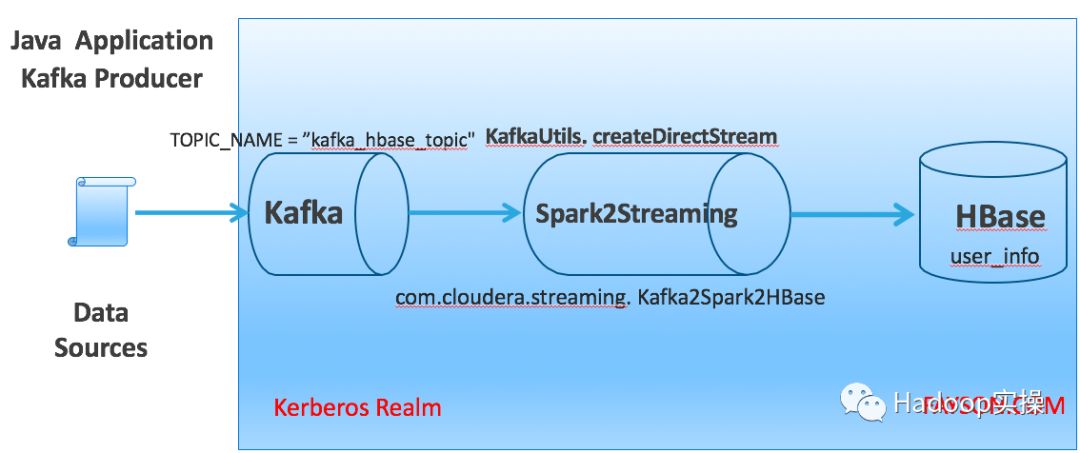
示例详细流程图如下:
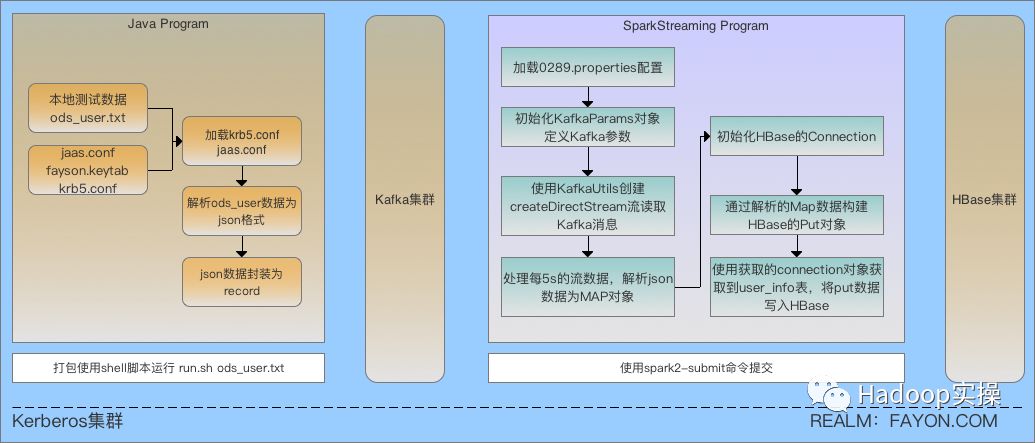
- 内容概述:
1.环境准备
2.Spark2Streaming示例开发
3.示例运行
4.总结
- 测试环境:
1.CM5.14.3/CDH5.14.2
2.CDK2.2.0(Apache Kafka0.10.2)
3.SPARK2.2.0
4.操作系统版本为Redhat7.3
5.采用root用户进行操作
6.集群已启用Kerberos
2.环境准备
1.准备访问Kafka的Keytab文件,使用xst命令导出keytab文件
[root@cdh01 ~]# kadmin.local Authenticating as principal hbase/admin@FAYSON.COM with password.kadmin.local: xst -norandkey -k fayson.keytab fayson@FAYSON.COM
(可左右滑动)

使用klist命令检查导出的keytab文件是否正确
[root@cdh01 ~]# klist -ek fayson.keytab
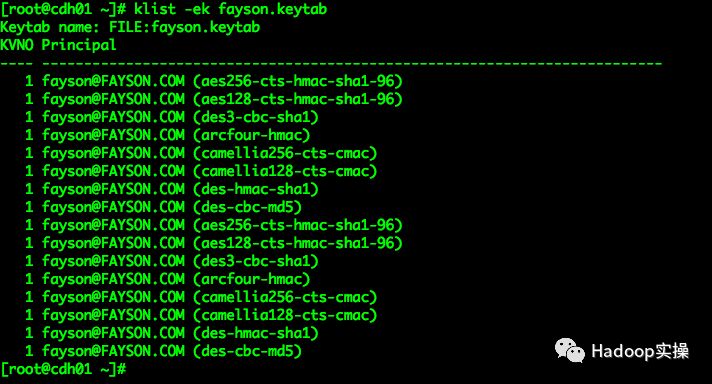
2. 准备jaas.cof文件内容如下:
KafkaClient { com.sun.security.auth.module.Krb5LoginModule required useKeyTab=true keyTab="/data/disk1/0286-kafka-shell/conf/fayson.keytab" principal="fayson@FAYSON.COM";};Client { com.sun.security.auth.module.Krb5LoginModule required useKeyTab=true storeKey=true keyTab="/data/disk1/0286-kafka-shell/conf/fayson.keytab" principal="fayson@FAYSON.COM";};
(可左右滑动)
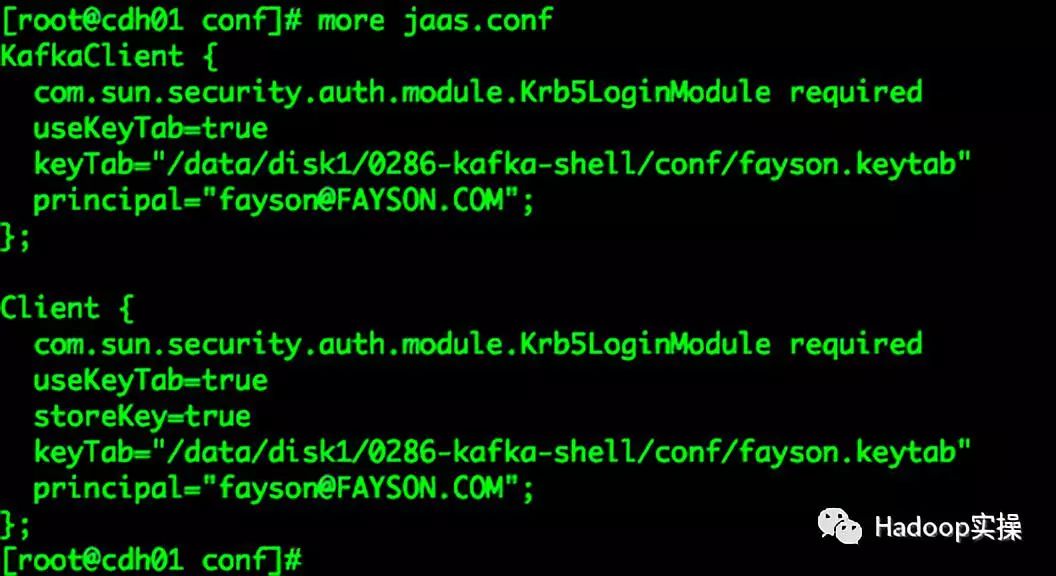
将fayson.keytab和jaas.conf文件拷贝至集群的所有节点统一的/data/disk1/0286-kafka-shell/conf目录下。
3. 准备向Kerberos环境发送数据的脚本,关于脚本这里就不在过多的介绍前面很多文章都有介绍,具体可以参考Fayson的GitHub:
https://github.com/fayson/cdhproject/tree/master/kafkademo/0286-kafka-shell
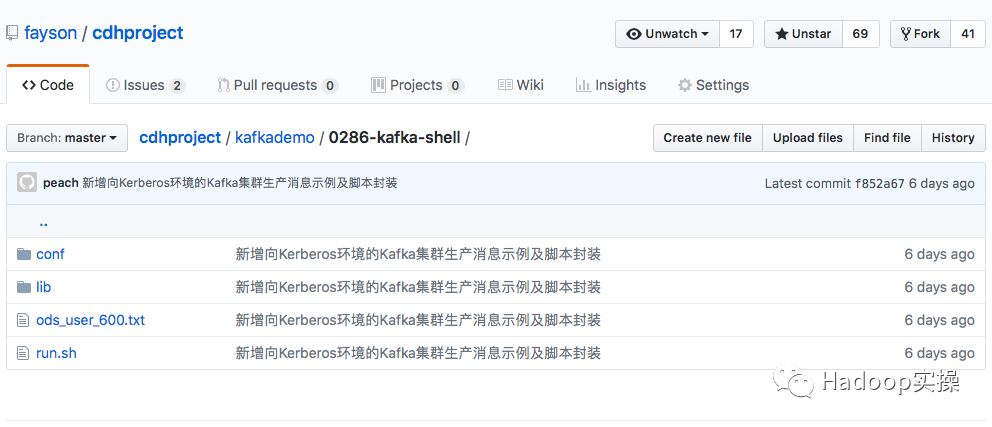
根据需要将conf下面的配置文件修改为自己集群的环境即可,发送至Kafka的JSON数据示例如下:
{ "occupation": "生产工作、运输工作和部分体力劳动者", "address": "台东东二路16号-8-8", "city": "长治", "marriage": "1", "sex": "1", "name": "仲淑兰", "mobile_phone_num": "13607268580", "bank_name": "广州银行31", "id": "510105197906185179", "child_num": "1", "fix_phone_num": "15004170180"}
(可左右滑动)
4.登录CM进入SPARK2服务的配置项将spark_kafka_version的kafka版本修改为0.10

5.通过CM下载HBase客户端配置文件
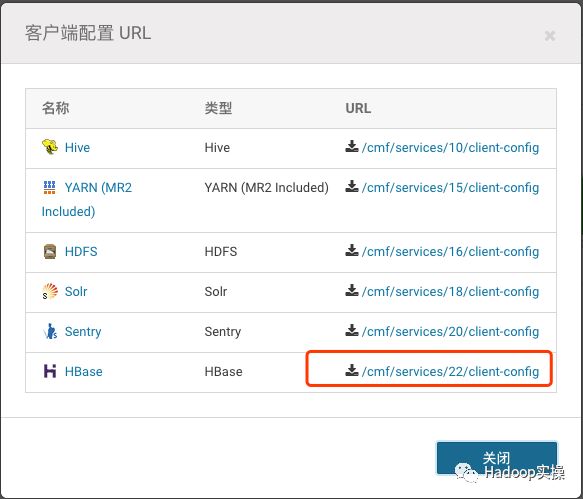
6.将Spark2访问HBase的依赖包添加到集群的/opt/cloudera/parcels/SPARK2/lib/spark2/jars目录下,依赖的jar包如下:
hbase-client-1.2.0-cdh5.14.2.jarhbase-common-1.2.0-cdh5.14.2.jarhbase-protocol-1.2.0-cdh5.14.2.jarhtrace-core-3.2.0-incubating.jar
(可左右滑动)
注意:需要将依赖包拷贝至集群所有节点。
3.Spark2Streaming示例开发
1.使用maven创建scala语言的spark2demo工程,pom.xml依赖如下
<dependency> <groupId>org.apache.hbase</groupId> <artifactId>hbase-client</artifactId> <version>1.2.0-cdh5.14.2</version></dependency>
(可左右滑动)
具体需要的依赖包,可以参考Fayson前面的文章《Spark2Streaming读Kerberos环境的Kafka并写数据到Kudu》
2.添加访问HBase的集群配置信息hdfs-site.xml/core-stie.xml/hbase-site.xml文件

3.在resources下创建0289.properties配置文件,内容如下:
kafka.brokers=cdh02.fayson.com:9092,cdh03.fayson.com:9092,cdh04.fayson.com:9092kafka.topics=kafka_hbase_topicprincipal.account=fayson@FAYSON.COMkeytab.filepath=/data/disk1/spark2streaming-kafka-hbase/conf/fayson.keytab
(可左右滑动)
4.创建HBaseUtils.scala类,主要用于创建HBase的Connection
package utilsimport java.io.Fileimport java.security.PrivilegedActionimport org.apache.hadoop.hbase.{HBaseConfiguration}import org.apache.hadoop.hbase.client.{Connection, ConnectionFactory}import org.apache.hadoop.security.UserGroupInformation/** * package: utils * describe: 访问Kerberos环境下的HBase * creat_user: Fayson * email: htechinfo@163.com * creat_date: 2018/6/25 * creat_time: 下午10:46 * 公众号:Hadoop实操 */object HBaseUtil { /** * HBase 配置文件路径 * @param confPath * @return */ def getHBaseConn(confPath: String, principal: String, keytabPath: String): Connection = { val configuration = HBaseConfiguration.create val coreFile = new File(confPath + File.separator + "core-site.xml") if(!coreFile.exists()) { val in = HBaseUtil.getClass.getClassLoader.getResourceAsStream("hbase-conf/core-site.xml") configuration.addResource(in) } val hdfsFile = new File(confPath + File.separator + "hdfs-site.xml") if(!hdfsFile.exists()) { val in = HBaseUtil.getClass.getClassLoader.getResourceAsStream("hbase-conf/hdfs-site.xml") configuration.addResource(in) } val hbaseFile = new File(confPath + File.separator + "hbase-site.xml") if(!hbaseFile.exists()) { val in = HBaseUtil.getClass.getClassLoader.getResourceAsStream("hbase-conf/hbase-site.xml") configuration.addResource(in) } UserGroupInformation.setConfiguration(configuration) UserGroupInformation.loginUserFromKeytab(principal, keytabPath) val loginUser = UserGroupInformation.getLoginUser loginUser.doAs(new PrivilegedAction[Connection] { override def run(): Connection = ConnectionFactory.createConnection(configuration) }) }}
(可左右滑动)
5.创建Kafka2Spark2HBase.scala文件,内容如下:
package com.cloudera.streamingimport java.io.{File, FileInputStream}import java.util.Propertiesimport org.apache.commons.lang.StringUtilsimport org.apache.hadoop.hbase.TableNameimport org.apache.hadoop.hbase.client.Putimport org.apache.hadoop.hbase.util.Bytesimport org.apache.kafka.common.serialization.StringDeserializerimport org.apache.log4j.{Level, Logger}import org.apache.spark.SparkConfimport org.apache.spark.sql.SparkSessionimport org.apache.spark.streaming.kafka010.{ConsumerStrategies, KafkaUtils, LocationStrategies}import org.apache.spark.streaming.{Seconds, StreamingContext}import utils.HBaseUtilimport scala.util.Tryimport scala.util.parsing.json.JSON/** * package: com.cloudera.streaming * describe: Kerberos环境中Spark2Streaming应用实时读取Kafka数据,解析后存入HBase * 使用spark2-submit的方式提交作业 * spark2-submit --class com.cloudera.streaming.Kafka2Spark2Hbase \ --master yarn \ --deploy-mode client \ --executor-memory 2g \ --executor-cores 2 \ --driver-memory 2g \ --num-executors 2 \ --queue default \ --principal fayson@FAYSON.COM \ --keytab /data/disk1/spark2streaming-kafka-hbase/conf/fayson.keytab \ --files "/data/disk1/spark2streaming-kafka-hbase/conf/jaas.conf#jaas.conf" \ --driver-java-options "-Djava.security.auth.login.config=/data/disk1/spark2streaming-kafka-hbase/conf/jaas.conf" \ --conf "spark.executor.extraJavaOptions=-Djava.security.auth.login.config=/data/disk1/spark2streaming-kafka-hbase/conf/jaas.conf" \ spark2-demo-1.0-SNAPSHOT.jar * creat_user: Fayson * email: htechinfo@163.com * creat_date: 2018/6/25 * creat_time: 下午10:40 * 公众号:Hadoop实操 */object Kafka2Spark2Hbase { Logger.getLogger("com").setLevel(Level.ERROR) //设置日志级别 var confPath: String = System.getProperty("user.dir") + File.separator + "conf" def main(args: Array[String]): Unit = { //加载配置文件 val properties = new Properties() val file = new File(confPath + File.separator + "0288.properties") if(!file.exists()) { val in = Kafka2Spark2Kudu.getClass.getClassLoader.getResourceAsStream("0289.properties") properties.load(in); } else { properties.load(new FileInputStream(confPath)) } val brokers = properties.getProperty("kafka.brokers") val topics = properties.getProperty("kafka.topics") val principal = properties.getProperty("principal.account") val keytabFilePath = properties.getProperty("keytab.filepath") println("kafka.brokers:" + brokers) println("kafka.topics:" + topics) if(StringUtils.isEmpty(brokers)|| StringUtils.isEmpty(topics) || StringUtils.isEmpty(principal) || StringUtils.isEmpty(keytabFilePath)) { println("未配置Kafka和Kerberos信息") System.exit(0) } val topicsSet = topics.split(",").toSet val spark = SparkSession.builder().appName("Kafka2Spark2HBase-kerberos").config(new SparkConf()).getOrCreate() val ssc = new StreamingContext(spark.sparkContext, Seconds(5)) //设置Spark时间窗口,每5s处理一次 val kafkaParams = Map[String, Object]("bootstrap.servers" -> brokers , "auto.offset.reset" -> "latest" , "security.protocol" -> "SASL_PLAINTEXT" , "sasl.kerberos.service.name" -> "kafka" , "key.deserializer" -> classOf[StringDeserializer] , "value.deserializer" -> classOf[StringDeserializer] , "group.id" -> "testgroup" ) val dStream = KafkaUtils.createDirectStream[String, String](ssc, LocationStrategies.PreferConsistent, ConsumerStrategies.Subscribe[String, String](topicsSet, kafkaParams)) dStream.foreachRDD(rdd => { rdd.foreachPartition(partitionRecords => { val connection = HBaseUtil.getHBaseConn(confPath, principal, keytabFilePath) // 获取Hbase连接 partitionRecords.foreach(line => { //将Kafka的每一条消息解析为JSON格式数据 val jsonObj = JSON.parseFull(line.value()) println(line.value()) val map:Map[String,Any] = jsonObj.get.asInstanceOf[Map[String, Any]] val rowkey = map.get("id").get.asInstanceOf[String] val name = map.get("name").get.asInstanceOf[String] val sex = map.get("sex").get.asInstanceOf[String] val city = map.get("city").get.asInstanceOf[String] val occupation = map.get("occupation").get.asInstanceOf[String] val mobile_phone_num = map.get("mobile_phone_num").get.asInstanceOf[String] val fix_phone_num = map.get("fix_phone_num").get.asInstanceOf[String] val bank_name = map.get("bank_name").get.asInstanceOf[String] val address = map.get("address").get.asInstanceOf[String] val marriage = map.get("marriage").get.asInstanceOf[String] val child_num = map.get("child_num").get.asInstanceOf[String] val tableName = TableName.valueOf("user_info") val table = connection.getTable(tableName) val put = new Put(Bytes.toBytes(rowkey)) put.addColumn(Bytes.toBytes("info"), Bytes.toBytes("name"), Bytes.toBytes(name)) put.addColumn(Bytes.toBytes("info"), Bytes.toBytes("sex"), Bytes.toBytes(sex)) put.addColumn(Bytes.toBytes("info"), Bytes.toBytes("city"), Bytes.toBytes(city)) put.addColumn(Bytes.toBytes("info"), Bytes.toBytes("occupation"), Bytes.toBytes(occupation)) put.addColumn(Bytes.toBytes("info"), Bytes.toBytes("mobile_phone_num"), Bytes.toBytes(mobile_phone_num)) put.addColumn(Bytes.toBytes("info"), Bytes.toBytes("fix_phone_num"), Bytes.toBytes(fix_phone_num)) put.addColumn(Bytes.toBytes("info"), Bytes.toBytes("bank_name"), Bytes.toBytes(bank_name)) put.addColumn(Bytes.toBytes("info"), Bytes.toBytes("address"), Bytes.toBytes(address)) put.addColumn(Bytes.toBytes("info"), Bytes.toBytes("marriage"), Bytes.toBytes(marriage)) put.addColumn(Bytes.toBytes("info"), Bytes.toBytes("child_num"), Bytes.toBytes(child_num)) Try(table.put(put)).getOrElse(table.close())//将数据写入HBase,若出错关闭table table.close()//分区数据写入HBase后关闭连接 }) connection.close() }) }) ssc.start() ssc.awaitTermination() }}
(可左右滑动)
6.使用mvn命令编译工程,注意由于是scala工程编译时mvn命令要加scala:compile
mvn clean scala:compile package7.将编译好的spark2-demo-1.0-SNAPSHOT.jar包上传至服务器

7.将编译好的spark2-demo-1.0-SNAPSHOT.jar包上传至服务器

将Spark2应用的配置文件放在conf目录下,内容如下:

0289.properties配置文件内容如下:

jaas.conf文件内容如下:
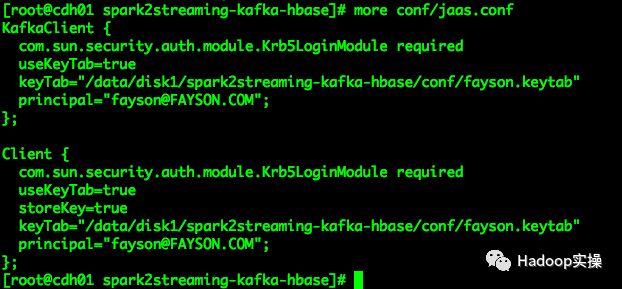
将spark2streaming-kafka-hbase目录拷贝至集群的所有节点
4.示例运行
1.使用spark2-submit命令向集群提交Spark2Streaming作业
spark2-submit --class com.cloudera.streaming.Kafka2Spark2Hbase \--master yarn \--deploy-mode client \--executor-memory 2g \--executor-cores 2 \--driver-memory 2g \--num-executors 2 \--queue default \--principal fayson@FAYSON.COM \--keytab /data/disk1/spark2streaming-kafka-hbase/conf/fayson.keytab \--files "/data/disk1/spark2streaming-kafka-hbase/conf/jaas.conf#jaas.conf" \--driver-java-options "-Djava.security.auth.login.config=/data/disk1/spark2streaming-kafka-hbase/conf/jaas.conf" \--conf "spark.executor.extraJavaOptions=-Djava.security.auth.login.config=/data/disk1/spark2streaming-kafka-hbase/conf/jaas.conf" \spark2-demo-1.0-SNAPSHOT.jar
(可左右滑动)
通过CM查看作业是否提交成功

Spark2的UI界面

2.运行脚本向Kafka的Kafka_hbase_topic生产消息

3.使用hbase shell命令查看数据是否入库成功

5.总结
1.本示例中SparkStreaming读取Kerberos环境的Kafka集群,使用的是spark-streaming-kafka0.10.0版本的依赖包,在Spark中提供两个的另外一个版本的为0.8.0版本,在选择依赖包时需要注意与Spark版本的兼容性问题,具体可以参考官网地址:
http://spark.apache.org/docs/2.2.0/streaming-kafka-integration.html
(可左右滑动)
2.在前面的文章Fayson也有介绍Java访问Kerberos环境的Kafka,需要使用到jaas.conf文件,这里的jaas.conf文件Fayson通过spark2-submit的方式指定,注意我们的jaas.conf文件及keytab需要在集群的所有节点存在,因为Driver和Executor是随机在集群的节点上启动的。
3.同样在scala代码中访问Kafka是也一样需要添加Kerberos相关的配置security.protocol和sasl.kerberos.service.name参数。
4.Spark2默认的kafka版本为0.9需要通过CM将默认的Kafka版本修改为0.10
5.注意在0289.properties配置文件中,指定了keytab文件的绝对路径,如果指定的为相对路径可能会出现Kerberos认证失败。
6.在访问Kerberos环境的HBase,需要加载HBase的客户端配置文件,因为在访问HBase时需要使用Hadoop的UserGroupInformation对象登录Kerberos账号,为了方便直接将三个配置文件加载。
GitHub地址如下:
https://github.com/fayson/cdhproject/blob/master/spark2demo/src/main/scala/utils/HBaseUtil.scala
本文分享自微信公众号 - Hadoop实操(gh_c4c535955d0f)。
如有侵权,请联系 support@oschina.cn 删除。
本文参与“OSC源创计划”,欢迎正在阅读的你也加入,一起分享。












